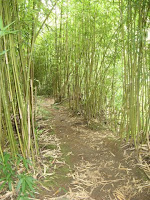
Aloha from upcountry!
Although we have been experiencing a nippy winter with a fair amount of rain, I was told recently that we are still in a drought. When the big rains come, it is often from the south, Kona storms. Those rains tend to run off into the ocean...now, that is a cryin' shame!
The Hawaiian word for fresh water is "wai". Wai Wai means wealth.
 In the beautiful and amazing district of Hana, on the eastern side of Maui, there is controversy about the fresh water that travels all the way to the central valley to water the sugar cane.
In the beautiful and amazing district of Hana, on the eastern side of Maui, there is controversy about the fresh water that travels all the way to the central valley to water the sugar cane.This system of canals was built in the 1870's, and still is in use today. The kalo, taro, farmers of Hana district need water to grow their taro crops. Taro is a very important plant in the Hawaiian culture. There are many remnants of the kalo terraces from ancient times.
I am posting some shots of a recent hike that I took with my grandchildren. We walked through this amazing bamboo forests to get to the waterfalls. Bamboo is an introduced species that is dominating in many areas of the islands.
 It grows incredibly fast, inches a day. It was intoduced to Hawaii during plantation times as a food source.
It grows incredibly fast, inches a day. It was intoduced to Hawaii during plantation times as a food source.The clacking of the bamboo as it sways in the wind is soothing. One has to be very mindful of where you plant it, and the variety you plant. The yellow elephant bamboo variety gets huge, and is very difficult to get rid of once it is going strong.
I just learned about the native Hawaiian bamboo. It does not grow that tall. I have yet to see it, but I'll be keeping my eyes open for it.
We are so blessed .
With Aloha,
Cherie







